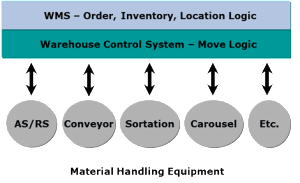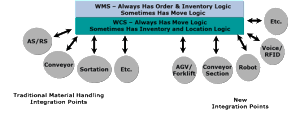Intelligent Forklifts Will Reshape Warehouse Control
by
Traditionally, we said that warehouses were operated in either a manual, semi-automated, or highly automated fashion. In a manual warehouse, pickers used carts, forklifts and other “dumb” forms of carriage to go to picking locations, gather the inventory, and deliver those goods to the shipping dock. However, forklifts are becoming intelligent. With the right kind of control system, a warehouse using forklifts becomes semi-automated.
Modern intelligent forklifts include diagnostics that allow the equipment to signal when it needs to be serviced, speed controls, anti-slip technology that monitors wheel spin and improve traction on slick floors, collision detection, fork speed optimization, and more.
Intelligent forklifts promote new process flows in the warehouse. When integrated to a WMS, the forklift’s fork and be raised or lowered much quicker. The WMS directs a forklift to a pick location. Once at the location, the forklift knows whether the pallet to be picked is being stored at a height of three feet, six feet, or whatever. The operator pushes a button on the console and the forks move at the maximum safe speed, a speed considerably faster than the operator would be apt to move them.
Speed controls can be used to help ensure safety. For example, RFID tags placed in the floor can signal the forklift that this is a busy section of a warehouse traversed by humans. The forklift automatically knows it cannot exceed a set speed, for example two miles per hour, and the governor automatically limits the top speed to two mph in those sections of the warehouse.
In mixed case picking, forklifts can integrate with pickers wearing voice systems, follow them up an aisle, lift the pallet to the correct ergonomic height for picking based upon the location of the inventory in the warehouse racking, and then, when ordered to do so, autonomously (without a human driver) make the trip to a shipping dock for unloading.
The most intelligent forklifts today are built with real-time location systems that allow drivers to proceed to a specified location and pick up (or put down) a load without the need for the driver to scan the location to prove that they have picked up (or delivered) the right load. This solution is designed for full pallet moves in either a warehouse with racks or a bulk warehouse in which pallets are stacked on top of each other.
The term “Internet of Things” is being increasing bandied about. In one definition of the term “Internet of Things,” almost all objects have sensors, connectivity to a broader environment, and intelligence. Sometimes the object just has a sliver of intelligence; but it can be much more substantial. Objects can be products, equipment, containers, or forms of material handling equipment including fork lifts.
The following diagram shows how warehouse management systems (WMS) WMS and warehouse control systems (WCS) have traditionally been visualized. The WMS contains the ORDER, INVENTORY and LOCA-TION logic. The WCS had the MOVE logic. The WMS knew that this many units of this SKU needed to be picked and where that inventory was located.
Traditional View of the WMS/WCS Architectural Stack
When inventory was inducted into the automated material handling sys-tem, it was the job of the WCS to MOVE those items. The WCS did not need to know what INVENTORY was being moved, or how that inventory fulfilled customer ORDERs.
Actually, in practice, it has often been more complicated than this. But this is still the way many in our field think about WMS vs. WCS.
Warehouse control in the age of the Internet of Things, requires a new conceptualization of WCS. A forklift that integrates through a control layer to some of the logic in a WMS to move its forks faster and more efficiently is engaged in a MOVE activity. That means intelligent forklifts need to be part of a larger warehouse control solution.
The New WMS/WCS Stack
In an era of distributed intelligence, a robotic revolution, and an environment in which new forms of “goods-to-man” automation are arising, it is inevitable that we will see value migrate from certain types of solution providers to others. Value is beginning to migrate toward more mobile (non-bolted down) forms of material handling used in goods-to-man processes.
WMS and material handling suppliers that can provide WCS solutions that can treat a forklift as an advanced form of automation, allow companies to add new forms of automation while protecting the WMS upgrade path, and provide logic that helps optimize throughput (even in warehouses where bottlenecks may shift over time between manual and material handling system choke points), will be the winners in this brave new world.



Comments
Post a Comment